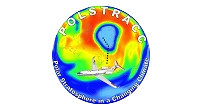Scientific objectives: Difference between revisions
From Polstracc
Content deleted Content added
No edit summary |
No edit summary |
||
| Line 1: | Line 1: | ||
Aiming on improving our understanding of the role of the Arctic stratosphere in the atmospheric system and improving future projections of the development of the ozone layer, the key objectives of POLSTRACC are: |
|||
== Key issues adressed by POLSTRACC are: == |
|||
* Investigating the structure, dynamics and chemical composition of the UTLS at high latitudes with a special focus on the Lowermost Stratosphere (LMS). Studies on the outflow of the polar vortex and its influence on the composition of the LMS at high and middle latitudes |
|||
* Improving the understanding of |
* Improving the understanding of catalytic processes involved in polar ozone loss with a focus on chlorine and bromine chemistry in the LMS |
||
* Improving the knowledge on polar stratospheric cloud (PSC) composition, de-/nitrification by sedimentation of nitric acid-containing particles and the role of gravity waves or orographic waves on PSC occurrence |
|||
* Detailed investigation of structure and composition of the climate-sensitive UTLS region at high latitudes with focus on the LMS region, the direct interface between stratosphere and tropopause |
|||
* Investigating Arctic cirrus clouds, their influence on the radiative forcing and their potential for denitrification, dehydration and chlorine activation |
|||
* Investigation of the outflow of the Arctic polar vortex into the LMS region, subsequent transport to lower latitudes and mixing with extra-vortex air |
|||
* Improving the knowledge on the properties of polar stratospheric clouds (PSCs) and vertical redistribution of nitrogen-containing compounds by PSC particles into the lower stratosphere |
|||
* Investigation of the role of Arctic cirrus clouds affecting the chemical composition and radiative budget of the Arctic UTLS |
|||
* Monitoring of the spatial and temporal variability of trace constituents and aerosols in the Arctic UTLS region during different phases of the polar winter |
|||
* Improving model simulations for the evolution of the ozone layer and the knowledge on the role of the Arctic UTLS region in the climate system |
|||
<br/> |
<br/> |
||
[[Category:One]] |
[[Category:One]] |
||
Revision as of 21:59, 8 October 2014
Aiming on improving our understanding of the role of the Arctic stratosphere in the atmospheric system and improving future projections of the development of the ozone layer, the key objectives of POLSTRACC are:
- Investigating the structure, dynamics and chemical composition of the UTLS at high latitudes with a special focus on the Lowermost Stratosphere (LMS). Studies on the outflow of the polar vortex and its influence on the composition of the LMS at high and middle latitudes
- Improving the understanding of catalytic processes involved in polar ozone loss with a focus on chlorine and bromine chemistry in the LMS
- Improving the knowledge on polar stratospheric cloud (PSC) composition, de-/nitrification by sedimentation of nitric acid-containing particles and the role of gravity waves or orographic waves on PSC occurrence
- Investigating Arctic cirrus clouds, their influence on the radiative forcing and their potential for denitrification, dehydration and chlorine activation
